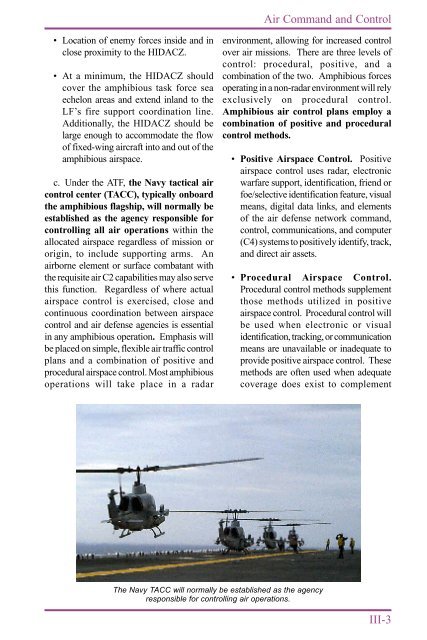Joint Doctrine for Amphibious Operations - Historic Naval Ships ...
Joint Doctrine for Amphibious Operations - Historic Naval Ships ...
Joint Doctrine for Amphibious Operations - Historic Naval Ships ...
- No tags were found...
You also want an ePaper? Increase the reach of your titles
YUMPU automatically turns print PDFs into web optimized ePapers that Google loves.
Air Command and Control• Location of enemy <strong>for</strong>ces inside and inclose proximity to the HIDACZ.• At a minimum, the HIDACZ shouldcover the amphibious task <strong>for</strong>ce seaechelon areas and extend inland to theLF’s fire support coordination line.Additionally, the HIDACZ should belarge enough to accommodate the flowof fixed-wing aircraft into and out of theamphibious airspace.c. Under the ATF, the Navy tactical aircontrol center (TACC), typically onboardthe amphibious flagship, will normally beestablished as the agency responsible <strong>for</strong>controlling all air operations within theallocated airspace regardless of mission ororigin, to include supporting arms. Anairborne element or surface combatant withthe requisite air C2 capabilities may also servethis function. Regardless of where actualairspace control is exercised, close andcontinuous coordination between airspacecontrol and air defense agencies is essentialin any amphibious operation. Emphasis willbe placed on simple, flexible air traffic controlplans and a combination of positive andprocedural airspace control. Most amphibiousoperations will take place in a radarenvironment, allowing <strong>for</strong> increased controlover air missions. There are three levels ofcontrol: procedural, positive, and acombination of the two. <strong>Amphibious</strong> <strong>for</strong>cesoperating in a non-radar environment will relyexclusively on procedural control.<strong>Amphibious</strong> air control plans employ acombination of positive and proceduralcontrol methods.• Positive Airspace Control. Positiveairspace control uses radar, electronicwarfare support, identification, friend orfoe/selective identification feature, visualmeans, digital data links, and elementsof the air defense network command,control, communications, and computer(C4) systems to positively identify, track,and direct air assets.• Procedural Airspace Control.Procedural control methods supplementthose methods utilized in positiveairspace control. Procedural control willbe used when electronic or visualidentification, tracking, or communicationmeans are unavailable or inadequate toprovide positive airspace control. Thesemethods are often used when adequatecoverage does exist to complementThe Navy TACC will normally be established as the agencyresponsible <strong>for</strong> controlling air operations.III-3
















